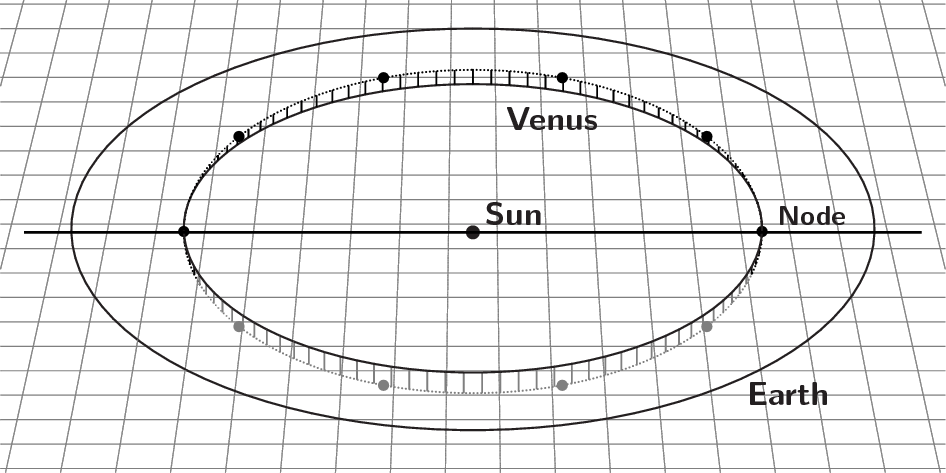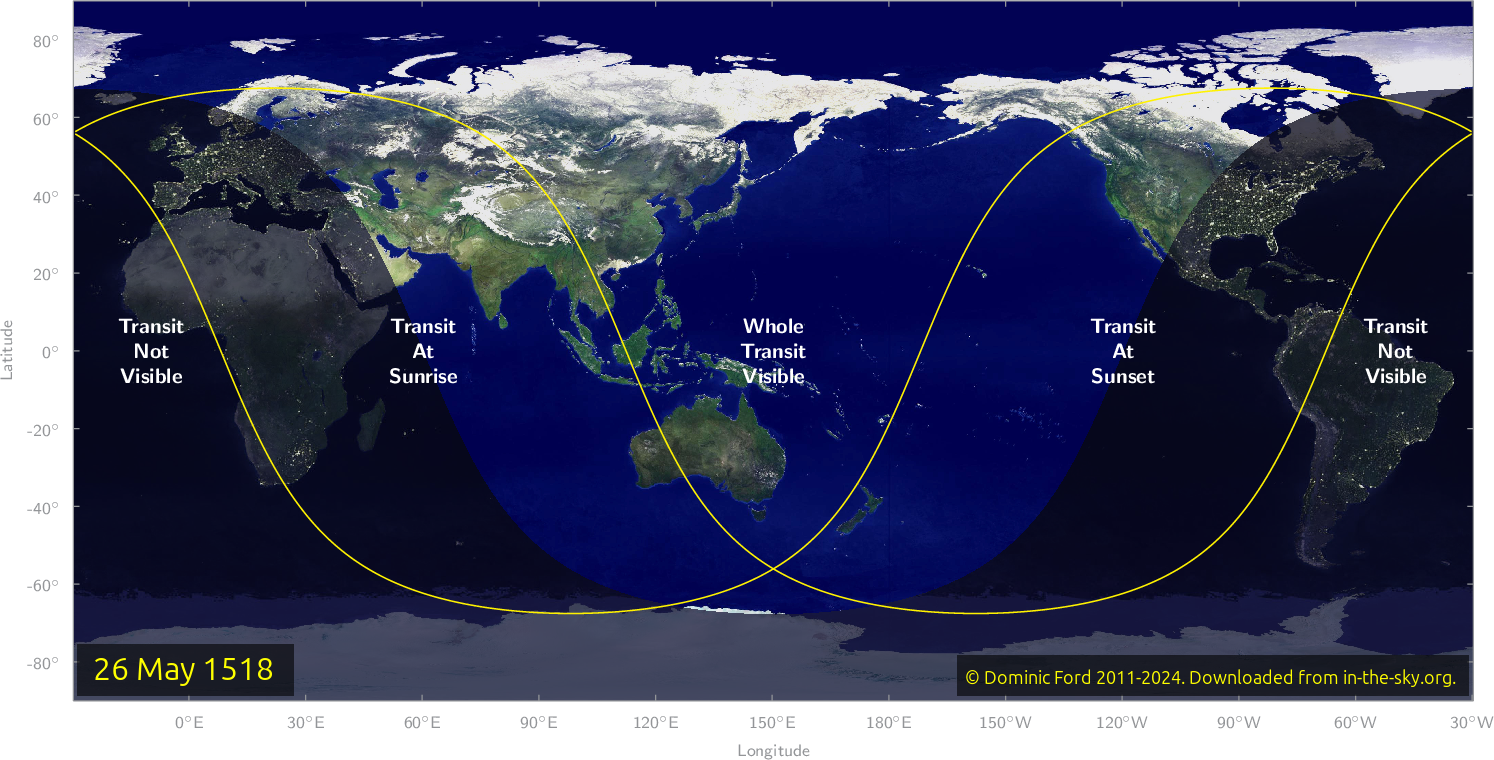| Start: | Tue, 25 May 1518 at 14:35 LMT (22:28 UTC) |
| End: | Tue, 26 May 1518 at 21:31 LMT (05:24 UTC) |
185,361 days ago
Dominic Ford, Editor
From
the Inner Planets
feed
Roughly 13–14 times each thousand years, Venus passes directly in front of the Sun, casting a black silhouette in front of the solar disk for a few hours. Such a transit will occur on 26 May 1518, lasting from 14:35 until 21:31 LMT.
Between those times, the transit will be visible from anywhere on Earth, providing the Sun is above the horizon, including from Russia, Asia, the Americas, Oceania, Alaska and Northern Europe.
Venus last transited the Sun in December 1396, and its next transit will be in June 1526.
Planetary alignment
Venus orbits the Sun once every 225 days, completing each revolution around the Sun in around 7–8 Earth months. Since Venus orbits the Sun more quickly than the Earth, it occasionally overtakes the Earth in its orbit, and at such times the two planets lie side-by-side in their respective orbits.
This alignment is called inferior solar conjunction and occurs once every 584 days (roughly 19 Earth months) – a period called Venus's synodic period. It takes place as Venus moves from the evening sky into the morning sky. Even though Venus invariably passes very close to the Sun at these times, it rarely passes exactly in front of the Sun's disk.
Venus orbits the Sun in a slightly different plane from the Earth: its orbit is tipped up at an angle of 3.4° relative to Earth's orbit. The diagram below show this inclination of Venus's orbit (not drawn to scale), with a grid representing the plane of the ecliptic – the plane in which the Earth orbits in Sun.

Venus spends much of its time significantly above or below the plane of the Earth's orbit, and at such times it cannot pass directly in front of the Sun. If it passes inferior conjunction at such a time, it will appear to pass to the side of the Sun.
Venus can only pass in front of the Sun if it passes inferior conjunction while it is also very close to the Earth–Sun plane. It crosses through this plane twice on each orbit around the Sun, roughly once every 112 days, at the points on the left and right sides of the diagram above. These points are called the nodes of Venus's orbit.
The nodes of Venus's orbit lie alongside the points along the Earth's orbit that as pass on around June 7 and December 9 each year. Consequently, transits of Venus can only ever occur within a 1–2 days of these two possible dates.
Due to the precession of the equinoxes, these two dates advance through the year at a rate of roughly one day every 100 years.
This requirement for Venus to pass one of the nodes of its orbit at the same time that it also passes inferior conjunction is met on average only once every 75 years, though transits do not occur at regular intervals.
Each time, Venus can be seen to pass in front of the Sun from any location where the Sun is above the horizon at the time.

Further reading
For more information about safely observing the Sun, we recommend Lee Macdonald's excellent book How to Observe the Sun Safely , published by Springer in 2012.
The position of Venus at the moment of closest approach to the centre of the Sun's disk will be:
The coordinates above are given in J2000.0.
Next/previous transits
| « Previous | Next » | |||
| Visible from the Contiguous United States | Worldwide | Worldwide | Visible from the Contiguous United States | |
| 01 Dec 1396 | 01 Dec 1396 | Transits of Venus | 02 Jun 1526 | 02 Jun 1526 |
| 01 Dec 1396 | 01 Dec 1396 | Transits | 02 Jun 1526 | 02 Jun 1526 |
The sky on 3 Dec 2025
| The sky on 3 December 2025 | ||||||||||||||||||||||||||||||||||
|
99% 13 days old |
All times shown in PST.
|
|||||||||||||||||||||||||||||||||
Warning
Never attempt to point a pair of binoculars or a telescope at an object close to the Sun. Doing so may result in immediate and permanent blindness.
Source
The circumstances of this event were computed using the DE430 planetary ephemeris published by the Jet Propulsion Laboratory (JPL).
This event was automatically generated by searching the ephemeris for planetary alignments which are of interest to amateur astronomers, and the text above was generated based on an estimate of your location.
Related news
| 04 Jun 1518 | – Transit of Venus |
| 02 Jun 1526 | – Transit of Venus |
Image credit
© NASA/Hinode 2012.


